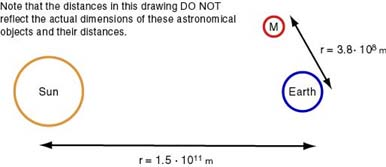Newtons Laws EX 39
The Moon is attracted towards the Earth by a gravitational force which depends on the mass of Earth ( kg), the mass of the Moon ( kg) and the distance between them ( m). See the diagram below showing the Moon, the Earth and the Sun.

Note that the quoted distance is really the radius of the Moon's orbit about the Earth. Using Newton's Law of gravitation we find
We compute the value of exerted on the Moon by the Earth to be equal to N.
The Moon is also attracted towards the Sun. The distance between the Moon and the Sun varies because the Moon is sometimes between the Earth and the Sun ("New Moon") or the Moon is on the opposite side of the Earth ("Full Moon"). Therefore the distance between the Sun and Moon is sometimes less than, sometimes greater than the distance between the Earth and Sun. Note that the distance from the Earth to the Sun is approximately 1000 times larger than the distance from the Earth to the Moon. Consider the following: if the distance between two cars is 1000 m and a man stands 1 m in front of the first car, his distance from the second car is 1001 m; if, on the other hand, he is behind the car then his distance from the other car is 999 m. Notice that the difference between these distances is "small" and that it is below the expected uncertainty of the measured distance between the cars. Therefore, in both cases, you might say that the man's distance from the second car is also 1000 m. Similarly, when we need to know the distance between the Moon and the Sun, we simply use the value of the distance between the Earth and the Sun. Again, applying Newton's law of gravitation we write
and see that the force exerted on the moon by the Sun is N. It is interesting to note that the force exerted by the Sun is only twice as large as the force exerted by the Earth even though the Earth is a million times smaller than the Sun!







